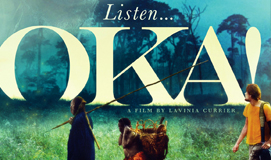—————an INK BARROW dispatch—————-
Here’s the first of many dispatches by our fearless reporter and social observer, Ink Barrow, the wayward niece of Ed Coaster.
On a gorgeous October day in the Virginia countryside, Ink sat on the porch with Suzanne Stroh, screenwriter of OKA!, the African feature film that opens October 14th in New York and Los Angeles.
Ink: How does it feel to have your first feature in theaters?
SSS: Fantastic. It’s a dream come true for any writer.
 Ink: How did you get on the project?
Ink: How did you get on the project?
SSS: It grew out of my friendship with the very talented filmmaker, Lavinia Currier, who is also a poet. I think we were talking poetry and poems over drinks in New York when she mentioned her work in CAR [Central African Republic]. She was so passionate about raising awareness, through film, about the plight of the Bayaka and other endangered species in the deep forest. She had two stories in development at that point. She’d gotten pretty extensive coverage, I think, but she still wasn’t sure how to proceed. She invited me to read both screenplays. I remember thinking that somewhere deep down in both stories, each beautiful in its own way, was the tale she wanted to tell. The job, I thought, was to imbue the funny misadventure of the hapless musicologist, Larry Whitman, with the pathos and mystery of OTA BENGA, the unproduced screenplay Lavinia had written with the novelist Rikki Ducornet.
Ink: You have a thing for unproduced screenplays.
SSS: I do. I wish more people enjoyed reading them. Nothing is so beautiful as that screenplay, OTA BENGA, by Currier and Ducornet. But Lavinia told me that after spending days in the village telling the true sad story of Ota Benga to her Bayakan friends, who would be actors in the ensemble cast, they said, ‘Oh no, that is a sad story. We do not tell those kinds of stories.’ So Lavinia decided to scrub the project.
Ink: Ota Benga, was that the pygmy character with the cameo in THE CURIOUS CASE OF BENJAMIN BUTTON?
SSS: Exactly. A Bayakan man kidnapped in the Congo, dragged around the country as a curiosity and then cast off when people lost interest in pygmies, made to strike poses in the dioramas at the Natural History Museum in New York, and then put on exhibit at the Bronx Zoo. After that shameful treatment, he came to a sad end. The whole tragedy is deeply disturbing, but as I say, it’s not the film Lavinia and the Bayaka wanted to make. They wanted a funny happy story, like the ones they tell themselves in the village.
Ink: So then what?
SSS: I shared my thoughts. And to my great surprise, Lavinia wanted to work with me on a rewrite.
Ink: Why surprised?
SSS: [Laughs]. Well Rikki Ducornet is an accomplished novelist and, clearly, a talented screenwriter. I admire Lavinia’s earlier film, PASSION IN THE DESERT, so I knew she was capable of writing the script on her own if her partner Louis Sarno was no longer available. Then there was the problem of my never having been to central Africa. What was my street cred?
Ink: You spoke French.
SSS: That’s right. My redeeming quality. Central Africa is a Francophone region. But the Bayaka in that part of the forest speak Aka. OKA! means “listen up!” in Aka.
Ink: So you worked from an existing draft?
SSS: Yes, it was important to keep close to the work that Lavinia had done with Louis Sarno, whose life inspires the character Larry Whitman. We also had primary sources to work from, including Louis’s wonderful book Song from the Forest and his hilarious unpublished memoirs, “Last Thoughts Before Vanishing From the Face of the Earth.” On top of that, Lavinia had many experiences of her own to fold in. And then James Bruce came on to produce, so we had notes from him.
Ink: Did you work on the set in Africa?
SSS: No, I waved goodbye to the script at customs.
Ink: Adaptations for the screen: what’s the takeaway for the screenwriter?
SSS: Hard to generalize. In rare cases it’s just “all about the story,” retelling the story, bringing out the story visually and through sound. Those are the easy adaptations. But as Spike Jonze and Charlie Kaufman’s great screenplay ADAPTATION teaches, the art’s in finding the heart of the material. Then you need to match it authentically to the movie the director and the producer want to make. It’s not always easy, but when you commit to that and stay faithful to that, there’s really a lot of room for creativity. It’s great work. Really engaging.
Ink: What’s another great adaptation?
SSS: There are so many. The Cohen Brothers did a marvelous job on TRUE GRIT. I recently worked on a remake, so I know how hard it is. But I loved adapting Lillian Faderman’s 19th century trial drama, Scotch Verdict, which tells the true story behind a famous 1934 play by Lillian Hellman, The Little Foxes. It was made into a controversial film, THE CHILDREN’S HOUR, that Shirley MacLaine won the best Actress Oscar for in 1963.
Ink: What a pedigree.
SSS: Absolutely. Quite the challenge to tell the true story, pay homage to what MacLaine and Hepburn accomplished in the 1960s, get to the heart of Lillian Faderman’s fascinating history, and still refresh the material, make something new.
Ink: All in a day’s work.
SSS: Which reminds me….
###
Ink Barrow | “Write with your spade, and garden with your pen”

You have more ufesul info than the British had colonies pre-WWII.